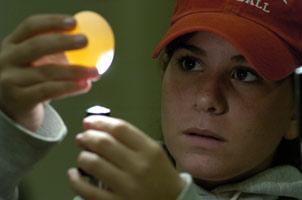Dana Research Assistantship at Dickinson

What is a Dana Research Assistantship?
The Purpose of a Dana Research Assistantship is to provide a faculty member with student assistance for their research project. The difference between a Dana Research Assistantship and a Collaborative Student-Faculty Research Project (SFR) is that a Dana provides a supporting role to the faculty member, as opposed to the collaborative role required in an SFR. A detailed description of the role of the student is required in the proposal.
Please note, however, that the primary purpose of the Dana program is the support of faculty scholarship and creative work through the involvement of students as research assistants. The College has other funding, not administered through R&D, for work-study positions to support the administrative activities of the College.
What activities are supported?
The Dana Research Assistant's duties may include:
- Conducting library and web research
- Compiling literature reviews
- Assisting with researching, planning, and mounting exhibitions and performances
- Assisting with lab experiments or field investigations
- Copy-editing and proofreading
- Indexing
- Fact-checking
- Locating or creating illustrations, charts, and graphs
- Compiling and annotating bibliographies
- Other substantive research assistance as needed
These duties may also include such incidental clerical tasks as photocopying and word-processing, but the core of the student's role should be more substantive tasks.
Please note that Dana projects do not provide funding for materials or supplies.
What criteria are used to determine funding?
The Danas will be awarded by the R&D Committee using the following criteria:
- Quality: What is the quality of the project in terms of significance, originality, and intellectual merit?
- Student role: The student role must be clearly defined and educationally substantial during every phase of the project. For summer Danas, students are expected to make a full-time commitment for the period of the project, which would prevent taking summer classes and having an additional job on campus.
- The college expects summer student assistants to make a full-time commitment, within consecutive weeks, for the length of the project - since student stipends are paid bi-weekly and housing is paid weekly. Any interruptions to the project dates can add to the cost of the project. Because of this, we advise you to hire students who will be able to work with you for the full eight consecutive weeks.
- Projects involve a close working relationship between the Dana Assistant and the faculty member. Significant mentorship is expected. Given available funding, the committee will consider requests for an additional student if there is a compelling rationale in the proposal.
- Projects normally occur on campus, and the student is expected to be in residence. In the case of fieldwork, the Dana Assistant and the faculty member will normally be at the same location.
- Finally, R&D looks to the ancestry of the project. The applicant's previous history of grant applications should indicate the ability to accomplish what was promised, to use awarded funds prudently, and to file final reports as required. Successful outcomes from previous projects will be a significant factor for repeat applications.
How are the Dana Assistantships supported?
For the summer assistantships, the student will be compensated at the rate of $450.00 per week for up to eight continuous weeks and the student's room in on-campus housing (or on-site equivalent). (Please note: if the project is on-campus, the student will be expected to live in campus housing during the time of the project.) The project dates must conform to the student housing constraints for summer. The college expects summer student assistants to make a full-time commitment, within consecutive weeks, for the length of the project -- since student stipends are paid bi-weekly and housing is paid weekly. Any interruptions to the project dates can add to the cost of the project. Because of this, we advise you to hire students who will be able to work with you for the full eight consecutive weeks.
For academic year assistantships, the student will be compensated at $10.00/hour of the Student Payroll Classification Plan and may be employed for up to 8 hours per week for 26 weeks. Project expenses for faculty may be applied for under the separate "Scholarly or Creative Project" category.
Please note that any outright expenses incurred by the student (e.g. travel; photocopying) must be covered through other sources; the Dana Student Research Assistantship program covers student stipends and room only.
Application instructions for this program:
- Please complete this online form with proposal application information at this link. R&D Application and Outline of Application
- If you have any difficulties or questions, please contact randd@dickinson.edu.
- Please be sure to check for Dana Assistantship proposal deadlines.
After approval of your academic year Dana awards, please complete the required forms. A Student Information and Honesty form will be enclosed with your award letter. Summer housing for students must be applied for by the students in the Gateway.
PLEASE NOTE: Part of the Dana experience requires the completion of a module on Responsible Conduct of Research. See Explanation and Form. Information will also be provided with the award letter.
Special reporting requirements for just this program:
Timely submission of a final report prepared by the student-faculty team will be expected. The final report should include:
- A summary of the research completed, including methods and results (150 words)
- The actual activities of the student researcher (150 words).
- The potential long-term benefits to the student of the completed project (150 words).
- Bibliographic citations of publication(s), presentation(s) or performance(s) resulting from this project, with actual or expected dates.
- Total number of hours worked by students for the year.
- Additionally, it is now required that the student attach to the final report a brief commentary (500 words maximum) stating what they accomplished as well as what they learned from this experience.
Resources to support this activity are also available at: